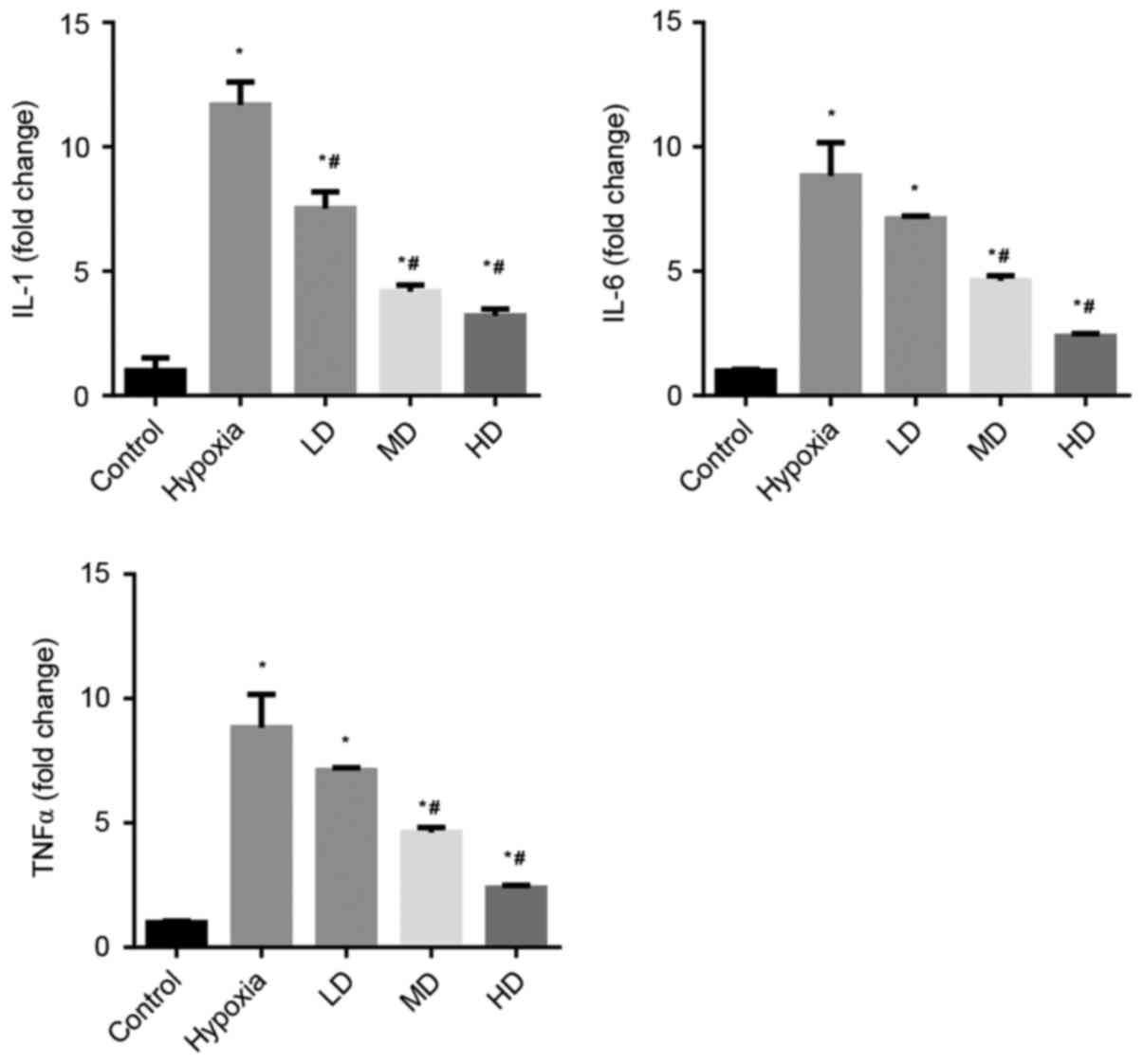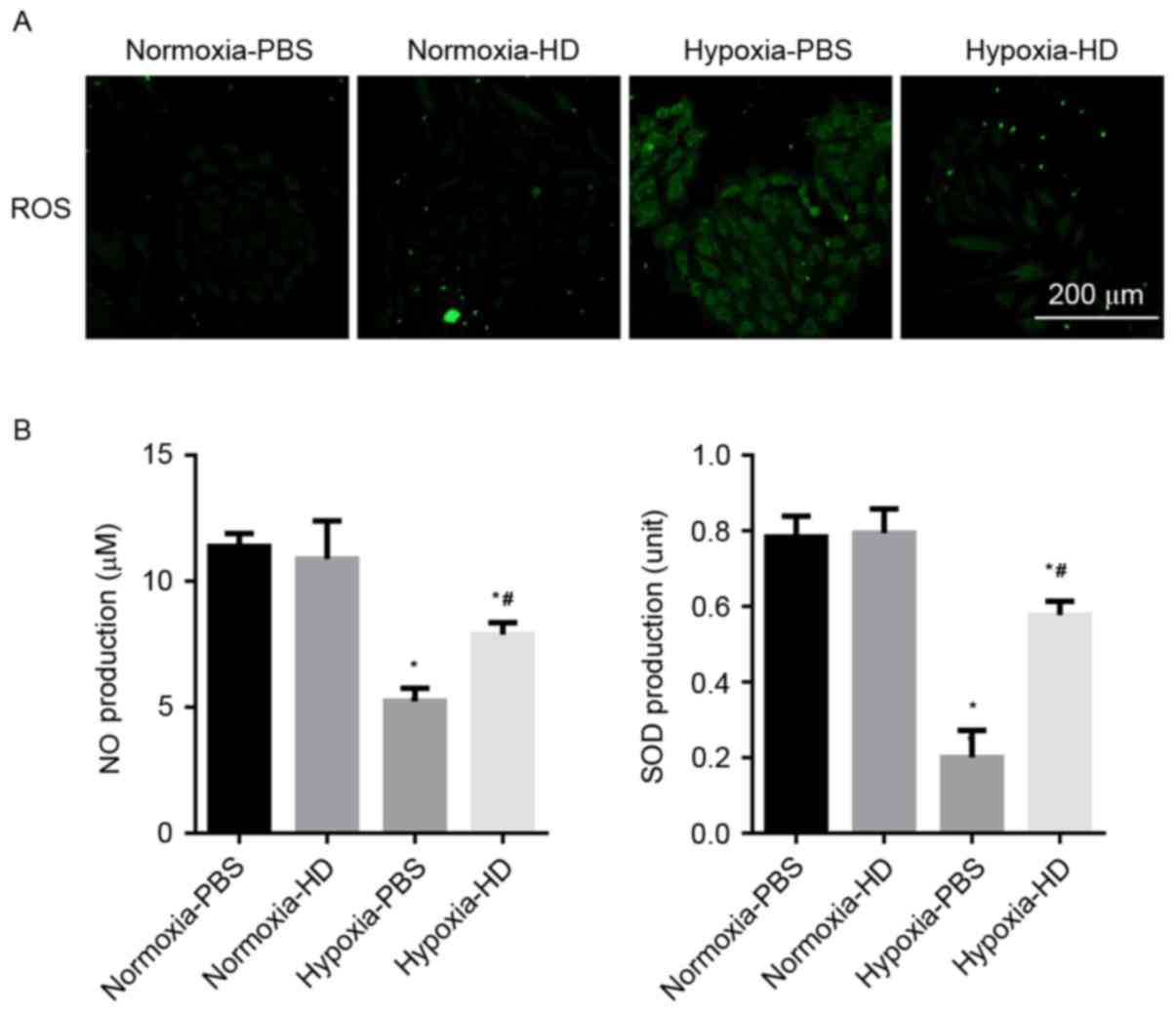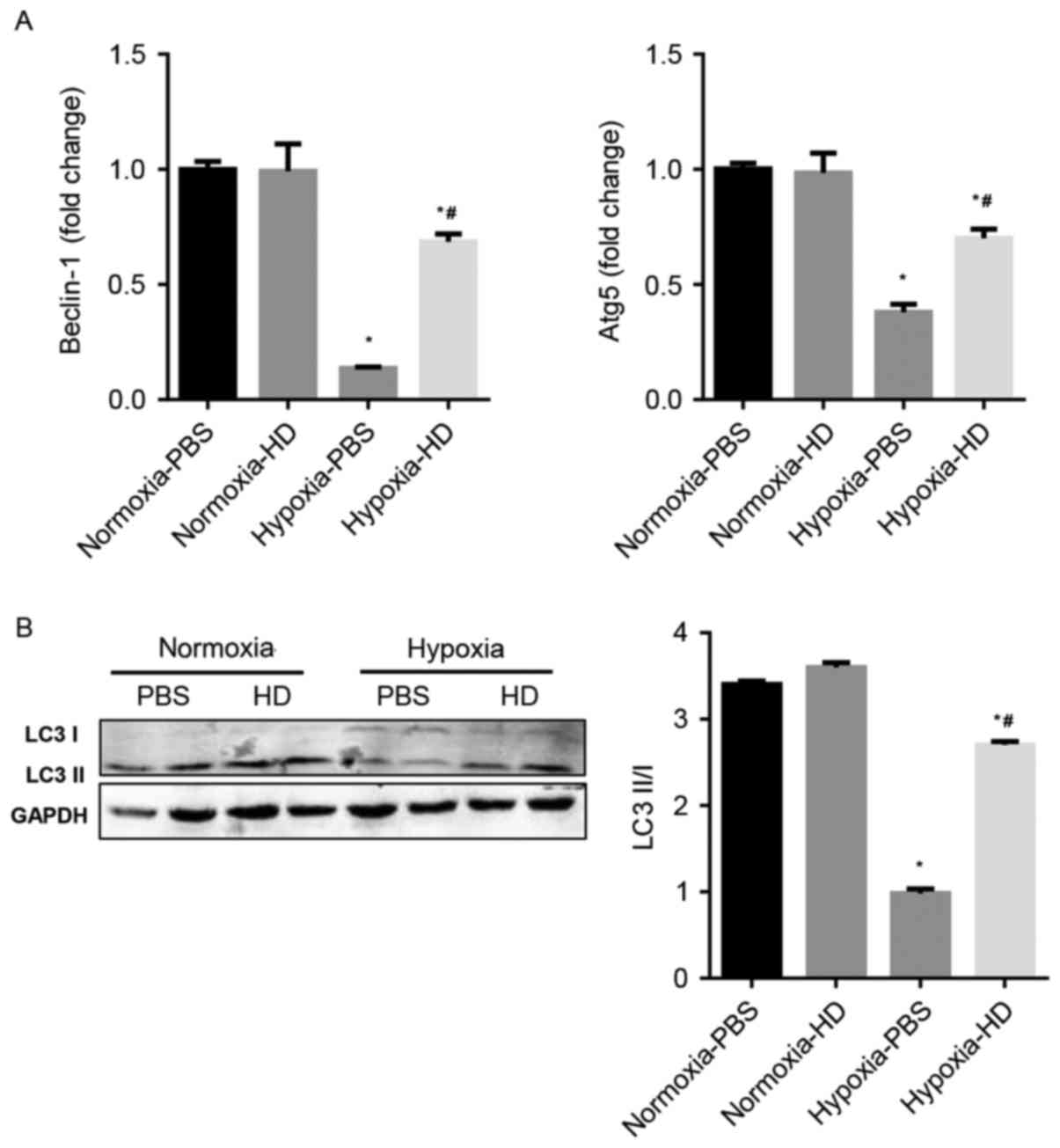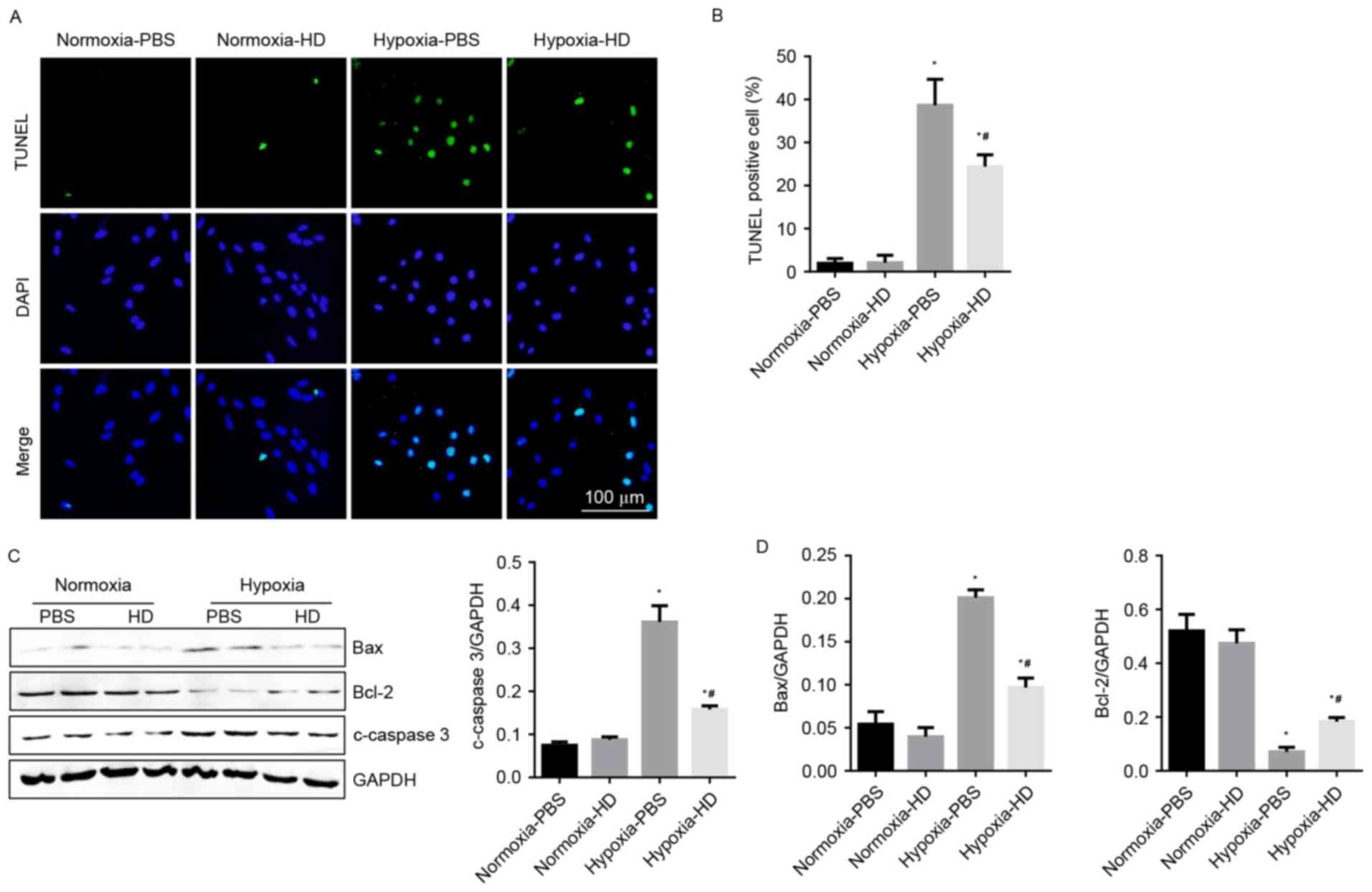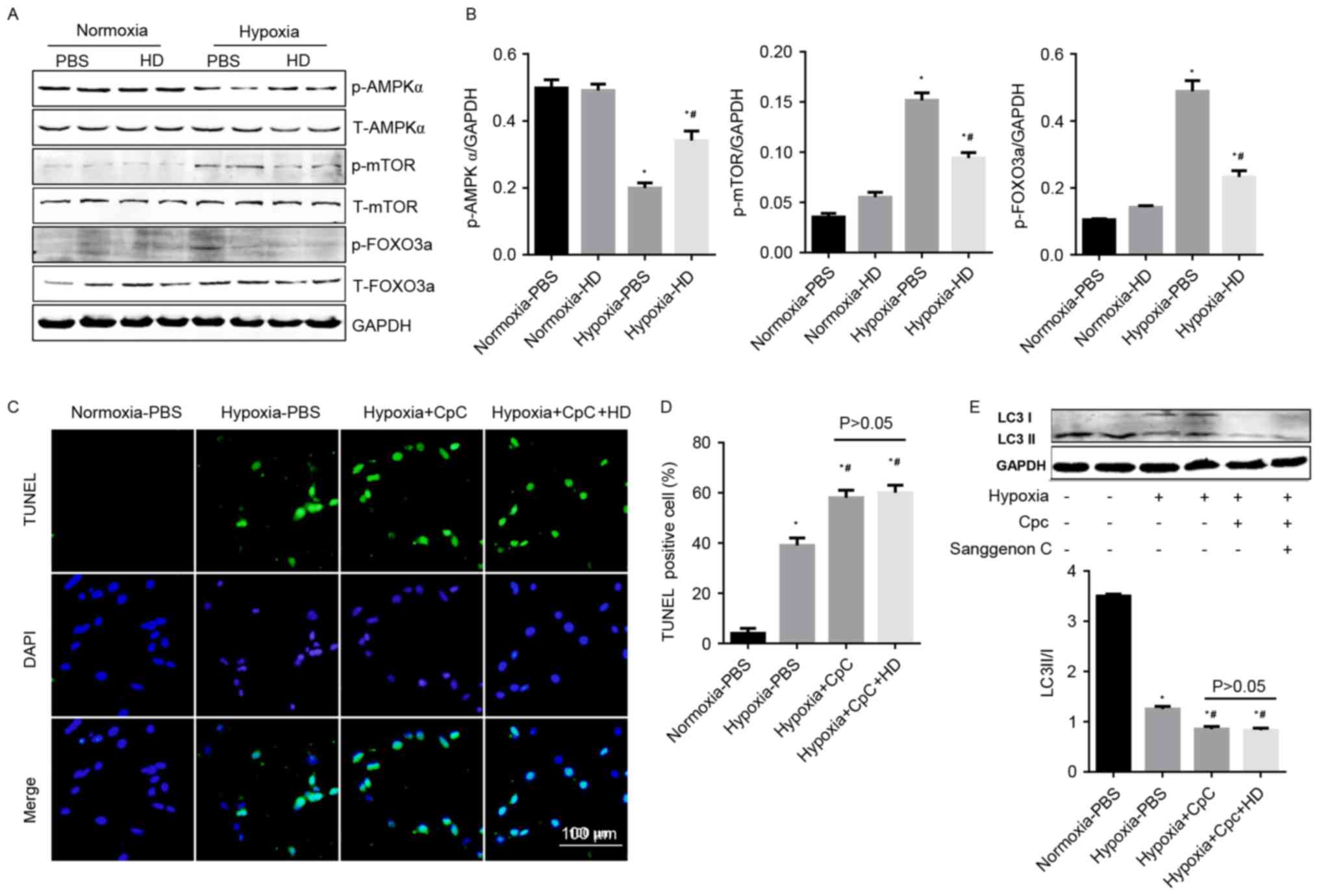Sanggenon C protects against cardiomyocyte hypoxia injury by increasing autophagy
- Authors:
- Published online on: September 27, 2017 https://doi.org/10.3892/mmr.2017.7646
- Pages: 8130-8136
-
Copyright: © Gu et al. This is an open access article distributed under the terms of Creative Commons Attribution License.
Abstract
Introduction
Acute myocardial infarction (AMI) results from a disruption of coronary blood flow to the myocardial region that it supplies. AMI remains the leading cause of mortality and is associated with a heavy financial burden worldwide (1). Prolonged cardiac ischemia can provoke tissue damage due to a lack of oxygen and nutrients since the heart demands high energy to function. The continuous deficiency of oxygen and nutrients alters ion homeostasis and metabolism, reducing cardiac contractility and structural organization, initiating cell death via necrosis and apoptosis (2). Cell death via necrosis is characterized by cell membrane rupture and the consequent release of cellular components (e.g., creatine kinase, troponin), which subsequently provokes an inflammatory response (3). The molecular mechanisms regarding ischemic injury are multifactorial. A growing number of studies have investigated the role that reactive oxygen species (ROS) serve in hypoxia, ranging from beneficial to damaging (4,5). At the basal level, ROS functions as a mediator for multiple cellular signaling cascades including cell growth and stress adaptation. In myocardial ischemia, excess ROS can damage tissues by oxidizing important cellular components such as proteins, lipids and DNA (4).
More recently, the role of autophagy in the pathogenesis of myocardial ischemic injury has been investigated. Autophagy is an evolutionarily conserved catabolic process that targets dysfunctional or damaged cytoplasmic constituents to the lysosome for degradation and recycling (6). Autophagy is essential for the survival of newborn mice between birth and the onset of suckling (7,8). Previous research has demonstrated that HL-1 cells overexpressing green fluorescent protein (GFP)-microtubule-associated proteins 1A/1B light chain 3 (LC3) exposed to 2 h of simulated ischemia in the absence of oxygen exhibited a low level of autophagy (9). Hamacher-Brady et al (9) reported that autophagy was completely blocked in HL-1 cells exposed to 2 h of simulated ischemia in the absence of oxygen. Inhibition of autophagy was achieved by treatments with either 3-methyladenine or wortmannin, downregulation of Beclin 1 or overexpression of autophagy related 5 (Atg5) K130R; all these interventions sensitized HL-1 cardiac cells to apoptosis induced by ischemia reperfusion. These indicate the cardioprotective effect of autophagy against ischemia injury. Considerable advances have been made in recognizing the molecular mechanisms that determine the protection afforded by these strategies. Pharmacological agents targeting key signaling effectors involved in the ischemic and reperfusion cascades have also been developed (10), while most of them have yielded disappointing results in clinical trials (11). Despite these setbacks, identifying novel potential ‘druggable’ targets for the clinical management of AMI is remains imminent.
Sanggenon C, a flavanone Diel-Alder adduct compound, is isolated from the root bark of Morus cathayana. A previous study has reported that by inhibiting proteasome function, Sanggenon C inhibits tumor cell viability via induction of cell cycle arrest and cell death (12). Sanggenon C also protected against lipopolysaccharide (LPS)-stimulated RAW264.7-cell inflammation by inhibiting nitric oxide (NO) production and inducible nitric oxide synthase expression via suppressing nuclear factor-κB (NF-κB) activity and NF-κB inhibitor α activation (13). By suppressing the activation of NF-κB, Sanggenon C inhibited tumor necrosis factor α (TNFα) stimulated human polymorphonuclear leukocyte adhesion to human synovial cell and expression of vascular cell adhesion molecule 1 (14). Since Sanggenon C possesses antioxidant and anti-inflammatory activities, it may serve as a cardioprotective agent. The purpose of our study was to determine the effects of Sanggenon C on cardiomyocyte hypoxia injury.
Materials and methods
Reagents
The primary antibodies included phosphorylated AMP-activated protein kinase α (p-AMPKα; cat. no. 2535), total (T)-AMPKα (cat. no. 2603P), p-mechanistic target of rapamycin (mTOR; cat. no. 2971), T-mTOR (cat. no. 2983), p-forkhead box O3a (FOXO3a; cat. no. 9465P), T-FOXO3a (cat. no. 2497P), Bcl-2 associated X apoptosis regulator (Bax; cat. no. 2722), Bcl-2 apoptosis regulator (Bcl-2; cat. no. 2870), and GAPDH (cat. no. 2118; all purchased from Cell Signaling Technology, Inc., Danvers, MA, USA). Sanggenon C (98% purity as determined by high-performance liquid chromatography analysis) was purchased from Shanghai Winherb Medical S&T Development Co., Ltd. (Shanghai, China). Fetal bovine serum was ordered from Gibco (Thermo Fisher Scientific, Inc., Waltham, MA, USA). The cell culture reagents were purchased from Gibco (Thermo Fisher Scientific, Inc.).
Cell culture
Rat cardiac H9c2 cells (Cell Bank of the Chinese Academy of Sciences, Shanghai, China) were cultured in Dulbecco's modified Eagle's medium (DMEM; cat. no. C11885; Gibco; Thermo Fisher Scientific, Inc.) supplemented with 10% fetal bovine serum (FBS; cat. no. 10099-133; Gibco; Thermo Fisher Scientific, Inc.,), 100 U/ml penicillin/100 mg/ml streptomycin (cat. no. 15140; Gibco; Thermo Fisher Scientific, Inc.) and 5% CO2 at 37°C. The media was changed every 1–2 days and subcultured to 70–80% confluency. Cells were plated at an appropriate density according to each experimental design. Cells were seeded at a density of 1×106/well onto 6-well culture plates for mRNA extraction, 5×103/well in 24-well plates for cell surface area examination and 10×107/well onto 10-cm diameter culture plates for protein extraction. Following 24 h adherence, the culture medium was changed to serum-free DMEM 12 h prior to the experiment. Cells were pretreated with Sanggenon C (1, 10 and 100 µM) and/or Compound C (CpC; 20 µM) for 12 h in serum-free DMEM at 37°C and then cells were maintained at 37°C, under a hypoxic atmosphere of 95% N2 and 5% CO2 for 24 h.
Reverse transcription-quantitative polymerase chain reaction (RT-qPCR)
Total RNA was extracted from frozen H9c2 cells using TRIzol (cat. no. 15596-026; Thermo Fisher Scientific, Inc.). RNA yield and purity were evaluated using a SmartSpec Plus Spectrophotometer (Bio-Rad Laboratories Inc., Hercules, CA, USA), comparing the absorbance (A) 260/A280 and A230/260 ratios. RT was performed on RNA (2 µg of each sample) to produce cDNA using oligo (dT) primers and the Transcriptor First Strand cDNA Synthesis kit (cat. no. 04896866001; Roche Diagnostics, Basel Switzerland). The PCR products were quantified using a LightCycler 480 SYBR-Green 1 Master mix (cat. no. 04707516001; Roche Diagnostics). Following an initial 5 min denaturation step at 95°C, a total of 42 primer-extension cycles were carried out. Each cycle consisted of a 10 sec denaturation step at 95°C, a 20 sec annealing step at 60°C, and a 20 sec incubation at 72°C for extension. Then a final extension step was performed at 72°C for 10 min. The double standard curve was used to quantify the PCR results. Calibrator normalized ratio = (concentration of sample target/concentrations of sample reference)/(concentration of calibrator target/concentration of calibrator reference) (15). The results were normalized against GAPDH gene expression. The sequences of the oligonucleotide primers (Sangon Biotech Co., Ltd., Shanghai, China) were as follows: TNFα forward, 5′-AGCATGATCCGAGATGTGGAA-3′ and reverse, 5′-TAGACAGAAGAGCGTGGTGGC-3′; interleukin-1 (IL-1) forward, 5′-GGGATGATGACGACCTGCTAG-3′ and reverse, 5′-ACCACTTGTTGGCTTATGTTCTG-3′; IL-6 forward, 5′-GTTGCCTTCTTGGGACTGATG-3′ and reverse, 5′-ATACTGGTCTGTTGTGGGTGGT-3′; Beclin-1 forward, 5′-AGCTTTTCTGGACTGTGTGC-3′ and reverse, 5′-TGAACTTGAGCGCCTTTGTC-3′; Atg5 forward, 5′-CAAGGATGCAGTTGAGGCTC-3′ and reverse, 5′-AGTTTCCGGTTGATGGTCCA-3′; p62 forward, 5′-AAGAGGCTCCATCACCAGAG-3′ and reverse, 5′-CCCCTTGACTCTGGCTGTAA-3′.
ROS measurement
The level of intracellular ROS generation was assessed using the fluorescent dye 2′,7′-dichlorofluorescin diacetate (DCFH-DA). Following the indicated treatments, cells were washed twice with PBS and then incubated with serum-free DMEM and 1×10−5 mol/l DCFH-DA in a 37°C incubator for 30 min. Subsequently, cells were washed with PBS for three times to eliminate the residual DCFH-DA. A fluorescence microscope (BX51; Olympus Corporation, Tokyo, Japan) was also used to evaluate the DCFH florescence of cells on coverslips.
Antioxidative assessments
Antioxidative capacity was assessed by the release of NO and the activity of SOD according to the protocol of the NO detection kit, SOD detection kit, respectively (Beyotime Institute of Biotechnology, Haimen, China). For NO detection, the supernatant was collected and transferred to another 96-well plate. The NO released from H9c2 cells was measured at 540 nm using spectrophotometer according to the manufacturer's instructions (Beyotime Institute of Biotechnology). For SOD assessment, proteins were extracted and quantified before measuring the activity of SOD at 450 nm using the commercial kit (Beyotime Institute of Biotechnology).
Terminal deoxynucleotidyl-transferase-mediated dUTP nick-end labelling (TUNEL) staining
Cells were cultured on cover slips in a 24-well plate, fixed in 4% paraformaldehyde for 5 min at room temperature and then permeabilized in 0.1% Triton X-100 for 5 min in room temperature following treatment. TUNEL staining according to the protocol of ApopTag® Plus Fluorescein in situ Apoptosis Detection kit (EMD Millipore, Billerica, MA, USA) for 1 h at 37°C. Nuclei were labeled with DAPI and DNA fragmentation was quantified under fluorescence microscope (magnification, ×200; BX51TRF; Olympus Corporation). The percentages of TUNEL-positive cells relative to DAPI-positive cells were calculated by an investigator in a blinded manner.
Western blot analysis
Cultured cardiac H9c2 cells were lysed in radioimmunoprecipitation (RIPA) lysis buffer [720 µl RIPA, 20 µl phenylmethylsulfonyl fluoride (1 mM), 100 µl cOmplete™ protease inhibitor cocktail (cat. no. 04693124001; Sigma-Aldrich; Merck KGaA, Darmstadt, Germany)], 100 µl phosSTOP (cat. no. 04906837001; Roche Diagnostics), 50 µl NaF (1 mM), 10 µl Na3VO4/ml and the protein concentration was measured by the bincinchoninic assay method. A total of 30 µg cell lysate was used for protein separation using SDS-PAGE on a 10% gel. The proteins were then transferred to polyvinylidene difluoride (PVDF) membranes (EMD Millipore). Specific protein expression levels were normalized to the GAPDH protein levels of the total cell lysate and cytosolic proteins on the same PVDF membranes, which were blocked with 5% non-fat milk at room temperature for 2 h. The following primary antibodies were used: p-AMPKα, T-AMPKα, p-mTOR, T-mTOR, p-FOXO3a, T-FOXO3a, Bax, Bcl-2, and GAPDH. The primary antibodies were diluted at 1:1,000. Antibody incubation was performed overnight with gentle shaking at 4°C. Quantification of the western blots was performed using an Odyssey infrared imaging system (LI-COR, Lincoln, NE, USA). The secondary antibodies, goat anti-rabbit IRdye® 800 CW (cat. no. 926-32211; LI-COR) IgG and goat anti-mouse IRdye 800 CW (cat. no. 926-32210; LI-COR), were used at a 1:10,000 dilution at 37°C in Odyssey blocking for 1 h. The blots were scanned using an infrared LI-COR scanner, allowing for simultaneous detection of two targets (phosphorylated and total protein) within the same experiment.
Statistical analysis
Data is expressed as the mean ± standard error of the mean. Differences among groups were determined by a two-way analysis of variance followed by Tukey's post hoc test. Statistical analyses were conducted using SPSS software (version 19.0; IBM Corp., Armonk, NY, USA). P<0.05 was considered to indicate a statistically significant difference.
Results
Sanggenon C suppresses hypoxia-induced inflammation in cardiomyocytes
The effects of Sanggenon C on the induction of TNFα, IL-1β and IL-6 in cardiomyocytes exposed to hypoxia were measured by RT-qPCR. The expression levels of pro-inflammatory cytokines TNFα, IL-1β and IL-6 were significantly increased in the hypoxia group. Sanggenon C treatment significantly attenuated this increase in a concentration-dependent manner (Fig. 1).
Sanggenon C inhibits the oxidative stress induced by hypoxia in cardiomyocytes
Cells incubated with DCFH-DA were used to determine the ROS production. A marked increase of ROS was observed in H9c2 cells exposed to hypoxia, while 100 µM Sanggenon C suppressed hypoxia-induced ROS generation. The effect of Sanggenon C on the release of antioxidants was also measured. Exposure to hypoxia for 24 h significantly decreased the release of NO and SOD activity in H9c2 cells and 100 µM Sanggenon C significantly attenuated this decrease (Fig. 2A and B).
Sanggenon C activates autophagy in response to hypoxia in cardiomyocytes
The effect of Sanggenon C on cardiomyocyte autophagy in response to hypoxia was explored. Previous studies have demonstrated that Beclin-1, p62, Atg5 and LC3 are autophagy-associated proteins and enhanced autophagy is accompanied by an increased ratio of LC3 II/LC3 I and Atg5 and Beclin-1 expression (16). The results demonstrated that autophagy significantly decreased in hypoxia-exposed cardiomyocytes, however increased in 100 µM Sanggenon C pre-treated cardiomyocytes (Fig. 3A and B).
Sanggenon C attenuates hypoxia-induced apoptosis in cardiomyocytes
To demonstrate the effect of Sanggenon C on cardiomyocyte apoptosis in response to hypoxia, TUNEL staining and western blotting were performed to detect cell apoptosis. Results revealed that the rate of apoptotic cells increased significantly after 24 h of hypoxia. Sanggenon C significantly reduced hypoxia-induced apoptosis (Fig. 4A and B). As expected, changes in expression of apoptosis-associated proteins were also consistent with the results above (Fig. 4C and D).
Effect of Sanggenon C on AMPKα/mTOR/FOXO3a signaling
Cellular energy levels are associated with the autophagy machinery by means of three major energy sensing pathways: AMPK, mTOR, and FOXO3a (16). In the current study, activated AMPKα was decreased, and phosphorylated mTOR and FOXO3a were increased in cardiomyocytes under hypoxia. Sanggenon C pre-treatment significantly increased the activation of AMPKα, and reduced the phosphorylation of mTOR and FOXO3a (Fig. 5A and B). To confirm the protective effects of Sanggenon C on hypoxia-induced cardiomyocyte injury were mediated by AMPKα signaling, an AMPKα inhibitor, CpC (20 µM) was used. The anti-apoptotic and pro-autophagy effects of Sanggenon C in response to hypoxia were abolished by CpC (Fig. 5C-E). The data indicated that enhanced autophagy and reduced inflammation, oxidative stress, apoptosis in Sanggenon C-pretreated cardiomyocytes exposed to hypoxia may be mediated through the regulation of the AMPKα/mTOR/FOXO3a signaling pathway.
Discussion
In the present study, it was demonstrated that Sanggenon C could increase cardiomyocyte autophagy in hypoxic conditions and prevent myocyte apoptosis. The increase in autophagy was associated with ROS clearance and the inhibition of inflammation, which would lead to cell death. The cardiac-protective effect of Sanggenon C was mediated by the modulation of AMPKα/mTOR/FOXO3a signaling.
In myocardial infarction and cardiomyocyte hypoxia, necrotic cardiomyocytes are capable of releasing a wide range of damage-associated molecular signals that activate innate immune pathways triggering an inflammatory response (17). Although inflammation is required for the phagocytotic removal of dead cells and for the activation of reparative mesenchymal cells, overactive, dysregulated, temporally-prolonged, or spatially expanded inflammatory responses may cause death of viable cardiomyocytes. This may also enhance matrix degradation (thus promoting dilative remodeling) and extend fibrosis (18). The oxidant and antioxidant imbalance within cardiomyocytes, which favors the accumulation of oxidants, can lead to cellular damage that constitutes oxidative stress (19). In the healthy myocardium, ROS is an unintended byproduct of mitochondrial respiration, where its concentration is tightly controlled to a low steady state level by antioxidants. However, in the ischemic heart, NO•, O2•−, and NO3− formation are elevated. The electron leakage from complexes I and III of the electron transport chain is primarily responsible for O2•− generation in mitochondria. This in turn damages the inner mitochondrial membrane, leading to decreased ATP production and then subsequently cellular damage (5). Previous studies have reported that Sanggenon C possesses antioxidant and anti-inflammatory activities (12,13). In addition to this, the present study demonstrated that Sanggenon C reduced the expression of pro-inflammatory cytokines, decreased ROS generation and increased the antioxidant production in cardiomyocytes in response to hypoxia.
Autophagy involves many actions that are essential for cell survival. It preserves energy availability and removes damaged organelles through limited cellular catabolism. Removal of damaged mitochondria is particularly important since these organelles produce ROS and contribute to cell stress and damage. Autophagy reduces pro-inflammatory signals by eliminating intracellular organisms, degrading pro-inflammatory signaling platforms, and by controlling cytokine production and release. Studies have demonstrated that cells exposed to 2 h of simulated ischemia in the absence of oxygen exhibited a low level of autophagy (9,20). It is widely agreed that autophagy elicited by myocardial infarction protects the heart from ischemic injury. Due to the abrupt interruption of exogenous nutrient supply, metabolites from autophagic digestion become a major source for energy production (21). Stimulation of autophagy in mice using TAT-p27 fusion protein reduces infarct size and improves cardiac performance following myocardial infarction (22). Furthermore, elevated basal levels of autophagy in communities that live at high altitudes are associated with diminished ischemia-reperfusion injury (23). The results of the current showed that autophagy reduced sharply after 24 h of hypoxia, whereas Sanggenon C-pretreatment induced cardiomyocyte autophagy. Increased autophagy in the Sanggenon C-treated cardiomyocyte may contribute to the protection against hypoxia.
To investigate the mechanism of induced autophagy following Sanggenon C treatment, the signal pathway associated with autophagy was detected. Autophagy is regulated by multiple signaling pathways, involving nutrients, stress, hormones, growth factors and intracellular energy information (8). AMPK, a sensor of the intracellular AMP/ATP ratio, is activated in response to elevated intracellular AMP by ATP hydrolysis. In conditions when ATP is depleted, AMPK is activated and subsequently phosphorylates eukaryotic elongation factor-2 kinase. This leads to a balance between the induction of autophagy and the inhibition of peptide elongation (24). AMPK also suppresses mTOR activity by interfering with GTPase activity, leading to the activation of autophagy (8). mTOR, a sensor of nutrients, is repressed under conditions of nutrient deprivation and hypoxia. Repression of mTOR promotes increased autophagic activity (25). FOXO3a, an evolutionarily conserved subfamily of transcription factors involved in regulation of energy metabolism, is also modulated by AMPK. Activation of the FOXO3a transcriptional program initially induces autophagy as an attempt to retain energy for cell survival (26). Treatment with Sanggenon C significantly increased the activation of AMPKα and FOXO3a, but suppressed the activation of mTOR in hypoxia cardiomyocytes. These results suggested that the regulation of AMPKα/mTOR/FOXO3a signal pathway by Sanggenon C is the compensatory mechanisms that induce autophagy and attenuate hypoxia injury in cardiomyocytes.
In conclusion, the current results supported the theory that Sanggenon C, administered as a pre-treatment prior to cardiomyocyte hypoxia, attenuates the inflammatory response and ROS production provoked during hypoxia. Notably, Sanggenon C was demonstrated to promote autophagy and render the cardiomyocyte resistant to hypoxic injury. The modulation of AMPKα/mTOR/FOXO3a signaling pathway restored autophagy as a reflex reaction.
Acknowledgements
This study was supported by the Applied and Technologic Research Program of Huai'an (grant no. HAS2014009) and the Research Fund for the Technology Development Project of Nanjing Medical University (grant no. 2013NJMU226).
References
|
Reed GW, Rossi JE and Cannon CP: Acute myocardial infarction. Lancet. 389:197–210. 2017. View Article : Google Scholar : PubMed/NCBI | |
|
Heusch G and Gersh BJ: The pathophysiology of acute myocardial infarction and strategies of protection beyond reperfusion: A continual challenge. Eur Heart J. 38:774–784. 2017.PubMed/NCBI | |
|
Westman PC, Lipinski MJ, Luger D, Waksman R, Bonow RO, Wu E and Epstein SE: Inflammation as a driver of adverse left ventricular remodeling after acute myocardial infarction. J Am Coll Cardiol. 67:2050–2060. 2016. View Article : Google Scholar : PubMed/NCBI | |
|
Zhou T, Chuang CC and Zuo L: Molecular characterization of reactive oxygen species in myocardial ischemia-reperfusion injury. Biomed Res Int. 2015:8649462015. View Article : Google Scholar : PubMed/NCBI | |
|
Kurian GA, Rajagopal R, Vedantham S and Rajesh M: The role of oxidative stress in myocardial ischemia and reperfusion injury and remodeling: Revisited. Oxid Med Cell Longev. 2016:16564502016. View Article : Google Scholar : PubMed/NCBI | |
|
Lippai M and Szatmári Z: Autophagy-from molecular mechanisms to clinical relevance. Cell Biol Toxicol. 33:145–168. 2016. View Article : Google Scholar : PubMed/NCBI | |
|
Nishida K and Otsu K: Autophagy during cardiac remodeling. J Mol Cell Cardiol. 95:11–18. 2016. View Article : Google Scholar : PubMed/NCBI | |
|
Chen-Scarabelli C, Agrawal PR, Saravolatz L, Abuniat C, Scarabelli G, Stephanou A, Loomba L, Narula J, Scarabelli TM and Knight R: The role and modulation of autophagy in experimental models of myocardial ischemia-reperfusion injury. J Geriatr Cardiol. 11:338–348. 2014.PubMed/NCBI | |
|
Hamacher-Brady A, Brady NR, Logue SE, Sayen MR, Jinno M, Kirshenbaum LA, Gottlieb RA and Gustafsson AB: Response to myocardial ischemia/reperfusion injury involves Bnip3 and autophagy. Cell Death Differ. 14:146–157. 2007. View Article : Google Scholar : PubMed/NCBI | |
|
Kharbanda RK: Cardiac conditioning: A review of evolving strategies to reduce ischaemia-reperfusion injury. Heart. 96:1179–1186. 2010. View Article : Google Scholar : PubMed/NCBI | |
|
Downey JM and Cohen MV: Why do we still not have cardioprotective drugs? Circ J. 73:1171–1177. 2009. View Article : Google Scholar : PubMed/NCBI | |
|
Huang H, Liu N, Zhao K, Zhu C, Lu X, Li S, Lian W, Zhou P, Dong X, Zhao C, et al: Sanggenon C decreases tumor cell viability associated with proteasome inhibition. Front Biosci (Elite Ed). 3:1315–1325. 2011.PubMed/NCBI | |
|
Dat NT, Binh PT, le TP Quynh, Huong HT and Minh CV: Sanggenon C and O inhibit NO production, iNOS expression and NF-κB activation in LPS-induced RAW264.7 cells. Immunopharmacol Immunotoxicol. 34:84–88. 2012. View Article : Google Scholar : PubMed/NCBI | |
|
Li LC, Shen F, Hou Q and Cheng GF: Inhibitory effect and mechanism of action of Sanggenon C on human polymorphonuclear leukocyte adhesion to human synovial cells. Acta Pharmacol Sin. 23:138–142. 2002.PubMed/NCBI | |
|
Livak KJ and Schmittgen TD: Analysis of relative gene expression data using real-time quantitative PCR and the 2(-Delta Delta C(T)) method. Methods. 25:402–408. 2001. View Article : Google Scholar : PubMed/NCBI | |
|
Nishida K, Kyoi S, Yamaguchi O, Sadoshima J and Otsu K: The role of autophagy in the heart. Cell Death Differ. 16:31–38. 2009. View Article : Google Scholar : PubMed/NCBI | |
|
Rienks M and Papageorgiou AP: Novel regulators of cardiac inflammation: Matricellular proteins expand their repertoire. J Mol Cell Cardiol. 91:172–178. 2016. View Article : Google Scholar : PubMed/NCBI | |
|
Frangogiannis NG: Inflammation in cardiac injury, repair and regeneration. Curr Opin Cardiol. 30:240–245. 2015. View Article : Google Scholar : PubMed/NCBI | |
|
Sun Y: Oxidative stress and cardiac repair/remodeling following infarction. Am J Med Sci. 334:197–205. 2007. View Article : Google Scholar : PubMed/NCBI | |
|
Hamacher-Brady A, Brady NR and Gottlieb RA: Enhancing macroautophagy protects against ischemia/reperfusion injury in cardiac myocytes. J Biol Chem. 281:29776–29787. 2006. View Article : Google Scholar : PubMed/NCBI | |
|
Wang ZV and Hill JA: Protein quality control and metabolism: Bidirectional control in the heart. Cell Metab. 21:215–226. 2015. View Article : Google Scholar : PubMed/NCBI | |
|
Sun X, Momen A, Wu J, Noyan H, Li R, von Harsdorf R and Husain M: p27 protein protects metabolically stressed cardiomyocytes from apoptosis by promoting autophagy. J Biol Chem. 289:16924–16935. 2014. View Article : Google Scholar : PubMed/NCBI | |
|
Hu Y, Sun Q, Li Z, Chen J, Shen C, Song Y and Zhong Q: High basal level of autophagy in high-altitude residents attenuates myocardial ischemia-reperfusion injury. J Thorac Cardiovasc Surg. 148:1674–1680. 2014. View Article : Google Scholar : PubMed/NCBI | |
|
Bairwa SC, Parajuli N and Dyck JR: The role of AMPK in cardiomyocyte health and survival. Biochim Biophys Acta. 1862:2199–2210. 2016. View Article : Google Scholar : PubMed/NCBI | |
|
Gallagher LE, Williamson LE and Chan EY: Advances in autophagy regulatory mechanisms. Cells. 5:pii: E242016. View Article : Google Scholar | |
|
Chiacchiera F and Simone C: The AMPK-FoxO3A axis as a target for cancer treatment. Cell Cycle. 9:1091–1096. 2010. View Article : Google Scholar : PubMed/NCBI |



